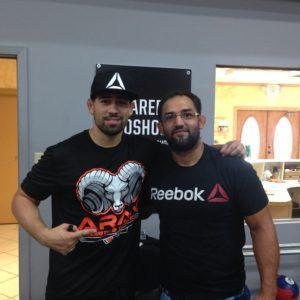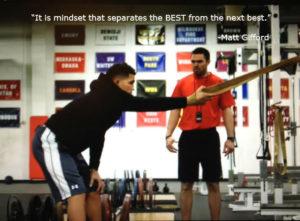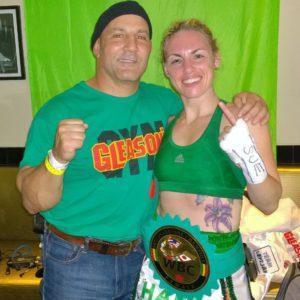
How Do You Know If You Are Ready To Fight?
By William Wayland
Have you ever wondered how to determine if a fighter is ready for a fight?
We recently received a question on the topic...
Mike asked... "I always wondered, is there a standard workout to determine readiness for a 3, 5 minute round mma fight? For track and field you can pretty much gauge your conditioning to the tee on what it needs to be. For football, there is the NFL combine. Is there such a thing for MMA?"
GREAT Question Mike!
Here is what some of our coaches had to say...
 Adrian Raul Ramirez, ARAM Strength and Conditioning
Adrian Raul Ramirez, ARAM Strength and Conditioning
I would a agree with a majority of the coaches on this link. If the testing is affordable it's definitely worth it . For example with Johny Hendricks in camp we get his blood work done every week and do BMI water testing every other week . It helps us monitor his training and his weight cut progression much better during camp . We can make adjustments to his nutrition and training based off the test results. As far as a combine training for mma there are a 4 things our coaches look for that we use to determine the level of athleticism in each athlete. Vertical Jump,Strength,Speed and mental strength. You can have all the attributes but if your mental strength and ability to overcome obstacles is not there it's hard to work with that athlete. In my experience with MMA athletes the two best ways to determine mental Strength and Ability are assessing how the athlete responds to coaching which includes listening to instruction and being able to make adjustments during the fight/sparring session. and the second way is seeing how the athlete responds to bad situations in a fight/sparring session. You can have the best athlete in the world if he doesn't respond to coaching or doesn't listen well then you will have problems.

Matt Gifford, NX Level Sports Performance
“It depends.” As a strength and conditioning idealist, I have found through experience that the MMA athlete is a jack of all trades and master of none. I have yet to come up with a perfect program in training the MMA fighter at large. Some of us probably deal with a rare athlete that has great aerobic capacity/power, keeps a favorable pH profile and also possesses great speed, power and maximal strength. The reality is that these athletes have a cluster**** of performance needs. I love block periodization protocols and conjugate programs alike. Speed, maximal strength, aerobic power and capacity all matter. If I have an athlete that has devastating striking than maybe I train him to focus more on those strengths. For example, an athlete I train has three straight first round knockouts. Good for him. The reality is he may need to with stand a twenty five minute fight come December. If you have a wrestling based ground and pound athlete do you care as much about power output or aerobic work on their feet or do you focus on isometrics, lactic threshold and strong man training…the answer is “it depends.” In the end I think we can agree that mma technique takes the cake and many roads lead to Rome.
Tom Furman, TomFurman.com
Fight 3 five minute rounds, period.
 Chad Macias, Institute of Human Kinetics
Chad Macias, Institute of Human Kinetics
Simply put no, Dominic Cruz responds completely different than Phil Davis to the same workload at the same intensity. This is why blood lactate testing should be a standard test used by everyone otherwise your literally guessing. I'm in the results business not the guessing business.
William Wayland, Powering Through
Due to variability of what happens in the sport we cannot have test determine the precise requirements fitness, its like trying to hit a moving target, T&F their parameters are very limited. We generally need to run a battery covering a number of qualities. Recovery measurement is probably a better means than some sort of standardized testing. Like Chad said, in an ideal world we would break out the lancets and have at it, substrate measurement would be best, HR tracking easier still. For me its not so much what is happening in the rounds but between them. I've seen numbers that MMA has a 3:2 work to rest ratio where as referring to the earlier point BJJ is 8:1, sometimes MMA can resemble a grappling match. Getting them to recover between efforts is crucial.
 Robert Forster, Phase IV
Robert Forster, Phase IV
Agreed, recovery between rounds is critical for performance and is an indicator of an athlete's fitness. The key in all anaerobic sports performance is the athlete's ability to push the anaerobic threshold up higher, that is to be able to produce more energy aerobically ie to burn fat as apposed to carbs at higher and higher intensity efforts. This gives that athlete the advantage of producing less lactic acid ( the by product of the anaerobic combustion of carbs.) Less lactic acid means less fatigue. AND a monster aerobic system allows athletes to clear the lactic acid they do produce because the aerobic fibers use lactic acid for energy production. This works for the world class sprinters, NBA players, wrestlers and fighters we train and enabled our 38 year old fighter Joe Warren to match the seemingly endless gas tank of his 25 year old opponent Eduardo Dantas and beat him for the Belt this past Saturday.
Sabina Skala, SabinaSkala.com
110% agree with what William said. We have some power endurance tests but they are more of a guideline for us to test if the things in the gym are progressing and if the recovery is getting better. Checking HR is the easiest and the most accessible way that every coach can use anywhere. Combat is too unpredictable to design a gym based test, as Tom says - fight 3x5 min round - easiest way , and even that varies from opponent to opponent.
 Tony Ricci, Coach Ricci
Tony Ricci, Coach Ricci
Everyone has provided some great input. HRV, Lactate, and will do RER at my lab here when I can get them in; which ain't often! This to try to push the anaerobic threshold up as Robert Forster stated so well, as to avoid a flood of H+ ions running all over the place, and sparing as much glucose and glycogen as I can for later rounds, particularly my boxers fighting 12x3.
Joey Alvarado, SoCal MMA
I have to agree with Tom Furman. For instance with my amateur fighters, they fight 3 x 2 minute rounds. I make them spar 6 x 2 minute rounds with a fresh person every round to determine if they are ready for the fight. 3 rounds of fighting in the cage equate to about 6 in training. You have to factor in nervousness and the adrenaline dump from fighting in front of a crowd.
Martin Rooney, Training for Warriors
Preparing for a fight involves a lot of different factors. Some guys need more skill and experience, while others need strength or conditioning. This is an interesting topic and we will continue to dig in and discuss.
If you have any input, please leave a comment below.
Got another question for us? Leave it below!



